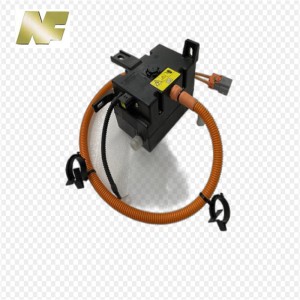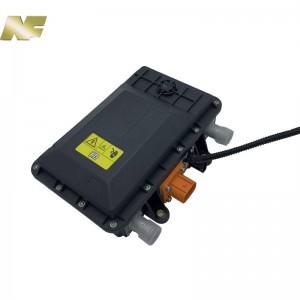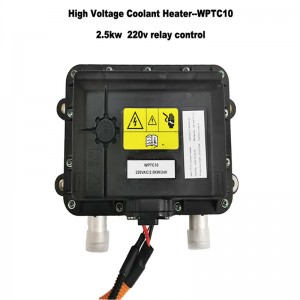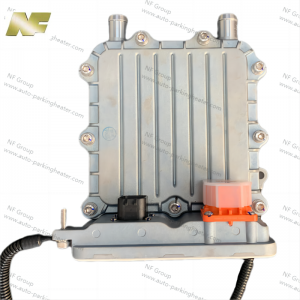NF 2.6KW PTC Coolant Heater DC360V High Voltage Coolant Heater
Description
Technical data:
1. Rated parameters: rated voltage is DC360V, voltage range is 280V-420V, coolant inlet temperature is 0±2℃, flow rate is 10L/min, power is 2.6KW±10%,
2. Under normal conditions, the insulation resistance is ≥100MΩ, the withstand voltage is 2100V/1s, and the leakage current < 10mA;
3. The maximum starting current ≤ 14.4A;
4. Other unmarked requirements shall be implemented according to Q/321191 AAM007;
5. The unmarked dimensional tolerance shall be implemented according to the C level in the limit deviation value of the linear dimension;
6. Weight: 2.1±0.1kg;
7. CAN control;
8. Heater control voltage is DC12V;
9. The protection level of the heater is IP67;
10. The date on the production batch number is engraved according to the specific date;
11. Appearance: The surface must not have scratches, burrs, and residual oil marks and other appearance defects;
12. Flame retardancy requirements: it should meet the requirements of GB8410-2006 combustion characteristics of automotive interior materials, and the combustion speed should be ≤ 100mm/min;
13. The material conforms to the "Requirements for Prohibited Substances in Automobiles" GB/T30512.
Technical Parameter
| OE NO. | NF WPTC-11 |
| Product Name | PTC Coolant Heater |
| Application | New energy hybrid and pure electric vehicles |
| High voltage range | 280V-420V |
| Rated power | 2.6KW±10% |
| Protection level | IP67 |
| Weight | 2.1KG |
| Maximum starting current | ≤ 14.4A |
| Rated Voltage | 12V |
| Communication | CAN |
| warranty period | 3 years |
| leakage current | < 10mA |
| Voltage Range | DC9V~DC16V |
Packaging & Shipping


Installation notes
1. Before powering on, make sure the installation is firm and the connectors are reliably connected.
2. The ground wire is reliably connected to prevent static electricity from damaging components.
3. Antifreeze must not contain impurities to prevent clogging of the water tank.
4. After unpacking, please be sure to check whether there is any appearance damage caused by transportation. Damage caused by improper installation and use (including use and installation conditions beyond the scope of the specification) are not covered by the warranty.
Application


Our Company
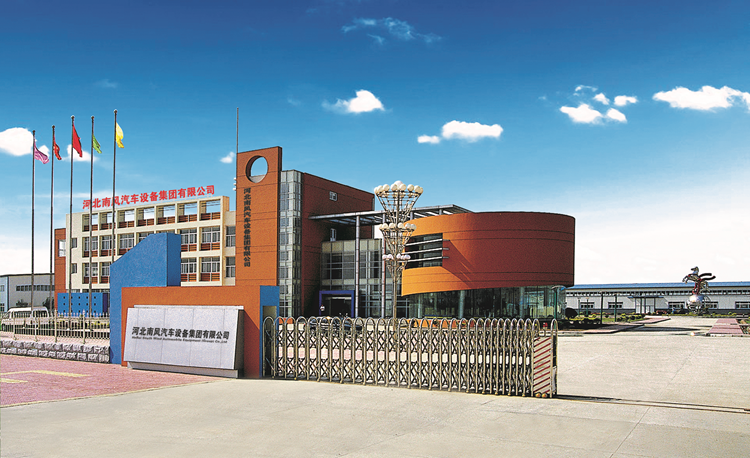

Hebei Nanfeng Automobile Equipment (Group) Co., Ltd is a group company with 5 factories, that specially produce parking heaters, heater parts, air conditioner and electric vehicle parts for more than 30 years. We are the leading auto parts manufacturers in China.
Our factory's production units are equipped with high tech machineries, strict quality,control testing devices and a team of professional technicians and engineers endorsing the quality and authenticity of our products.
In 2006, our company has passed ISO/TS16949:2002 quality management system certification. We also bagged the CE certificate and Emark certificate making us among the only few companies in the world acquiring such high level certifications.
Currently being the largest stakeholders in China, we hold a domestic market share of 40% and then we export them around the globe particularly in Asia, Europe and Americas.
Meeting the standards and demands of our customers have always been our top priority. It always encourages our experts to continuously brain storm, innovate, design and manufacture new products, impeccably suitable for the Chinese market and our customers from every nook of the world.
FAQ
Q1: What is a high-voltage PTC heater?
A1: A high-voltage PTC (positive temperature coefficient) heater is an electrical device that uses PTC material to generate heat when electric current passes through it. These heaters are designed to operate at high voltages, typically ranging from 120V to 480V, and can reach high temperatures quickly.
Q2: How does the high-voltage PTC heater work?
A2: High-voltage PTC heaters are composed of heating elements made of PTC materials such as ceramics or polymers. As the temperature rises, its resistance increases dramatically. When the heater is powered by a high voltage source, the initial current surge causes the PTC material to heat up rapidly, quickly reaching its maximum operating temperature. Once this temperature is reached, the resistance of the PTC material increases, limiting the amount of current flowing through it, thereby maintaining a stable temperature output.
Q3: What are the advantages of high-voltage PTC heaters?
A3: High-voltage PTC heaters have many advantages. They are self-regulating, meaning they automatically adjust power output as temperature changes, providing consistent heating without the need for external controls. These heaters also have fast response times, reaching high temperatures quickly and then maintaining a stable temperature. Additionally, they are relatively safe as they cannot undergo thermal runaway and do not require additional protection devices such as thermostats.
Q4: Where are high-voltage PTC heaters commonly used?
A4: High-voltage PTC heaters are widely used in various industries such as automobiles, aerospace, electronics, and medical. They are commonly used for temperature control in heating systems, air and gas heating, 3D printers, dehumidifiers, industrial drying processes, incubators and many other heating applications that require high power and fast response.
Q5: Can high-voltage PTC heaters be used outdoors?
A5: Yes, high-voltage PTC heater is suitable for outdoor use. They are designed to withstand harsh environmental conditions and maintain their performance even in extreme temperatures. However, it is important to ensure that the heater is suitable for the specific outdoor application to prevent any damage or malfunction.
Q6: Is the high-voltage PTC heater energy-saving?
A6: Yes, high voltage PTC heaters are known for their energy efficiency. Their self-regulating properties help automatically adjust power output based on ambient temperature, optimizing energy consumption. This eliminates the need for external temperature control equipment and reduces energy waste, making it a cost-effective heating solution.
Q7: Can high-voltage PTC heaters be used in hazardous areas?
A7: Yes, high voltage PTC heaters can be used in hazardous areas. Some models of PTC heaters are equipped with explosion-proof or explosion-proof housings to ensure safe operation in environments where flammable gases, vapors or combustible dusts may be present.
Q8: Is the high-voltage PTC heater easy to install?
A8: Yes, high voltage PTC heaters are usually simple to install. They often come with mounting brackets or flanges to allow for easy attachment to the desired surface. However, it is important to follow the manufacturer's installation instructions and ensure proper electrical connections to ensure safe and efficient operation.
Q9: Can high-voltage PTC heaters be used in humid environments?
A9: Yes, high-voltage PTC heaters can be used in humid environments. Many models are designed with waterproof casings, allowing them to withstand humidity and moisture. However, it is crucial to choose a heater specifically designed for wet environments and follow any additional safety guidelines provided by the manufacturer.
Q10: Does the high-voltage PTC heater require regular maintenance?
A10: High-voltage PTC heaters generally do not require much maintenance. However, it is recommended to check the heater regularly for any signs of damage or wear and ensure it is properly cleaned to prevent the build-up of dust or debris. Additionally, it is recommended to follow any maintenance recommendations provided by the manufacturer to ensure long-term, trouble-free operation.



